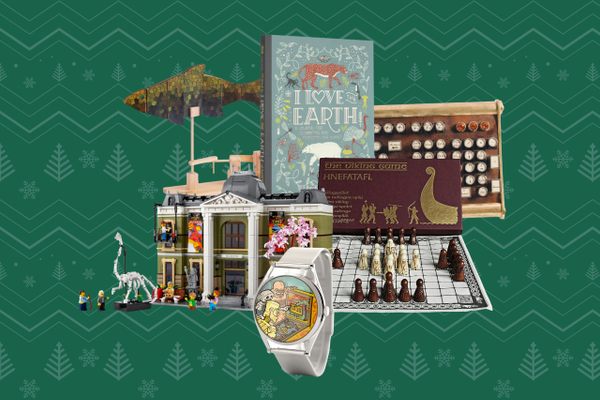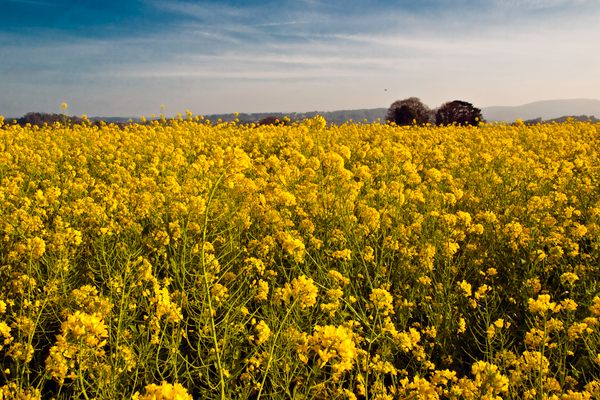New Clues Emerge About the Fluffy Dogs Once Bred for Their Wool
The story of these distinctive doggos is emerging from ancestral knowledge of the Coast Salish peoples and a new genetic study of the pelt of a pup named Mutton.
For tens of thousands of years, humans have seen dogs as guardians, hunters, and companions. Coast Salish peoples—Salish-speaking Indigenous groups in Washington state and British Columbia—bred packs of fluffy white dogs with curly tails and pointed ears as part of the family, but with another purpose in mind. “Woolly dogs” looked a bit like modern spitz breeds such as Samoyeds, American Eskimo dogs, or Shiba Inus, with long, mountain goat–like hair. They were bred and kept for grooming or shearing, and their coats then made into a variety of textiles, including finely woven blankets.
Dogs were introduced to the Americas from Eurasia about 15,000 years ago, and archaeology dates woolly dogs to about 5,000 years ago, while Coast Salish oral histories suggest an even longer history. In the mid-19th century, the woolly dogs and products made from their coats began to vanish, and the breed went extinct in the early 20th century. The true history of the dogs—which still hold great importance among Coast Salish communities—has been clouded by centuries of colonialism. But Coast Salish peoples have kept stories of the iconic dogs alive. Now, the world’s only known pelt of a Salish woolly dog, who was named Mutton, is helping researchers at the Smithsonian National Museum of Natural History, in partnership with Coast Salish communities, straighten out the breed’s fuzzy past.
A new study published in Science, reports on genomic testing of Mutton’s pelt, which has helped narrow in on what genes yielded the dogs’ lush coat, and revealed that Mutton—who was born in the late 1850s, after settlers and their European dogs arrived—was still primarily related to precolonial dog breeds. The scientific findings were informed by interviews and collaborations with Coast Salish Elders, Knowledge Keepers, and Master Weavers, and supported what locals have long known—that Indigenous peoples actively bred, cared for, and protected the finely tuned genetics of the woolly dog, even after European settlers arrived.

“This was a wonderful opportunity to weave the most advanced Western scientific methods with the most entrusted traditional Ancestral knowledge,” says coauthor Michael Pavel, an Elder from the Skokomish/Twana Coast Salish community in Washington. “Together, these two bodies of knowledge raise the level of understanding of the woolly dog, its origins, its purpose, and its contribution to our way of life, in what it did, and does, and will continue to mean to us as Indigenous people in the Salish Sea territory.”
“A dog is a man’s best friend,” the old adage goes, but Salish woolly dogs—who were considered extensions of the family—were doted on by women. Blankets, robes, and regalia of the region incorporated the dog fleece, mixed with plant fibers, goat wool, and waterfowl down. Wearing a woolly dog blanket wasn’t just like throwing on any old coat, says Pavel. The dogs were revered as spiritual creatures, and their fur retained not just heat, but prayers, he says. Some Western scholars previously suggested that dog fleece blankets went out of fashion with the arrival of colonial, machine-made blankets, popularized and traded for furs by the Hudson’s Bay Company, but this ignores the spiritual and cultural value they held, the researchers say. “That doesn’t pay attention to the cultural importance or 4,000 years of intentional breeding, and what it meant to have those blankets,” says Coast Salish textiles researcher Liz Hammond-Kaarremaa, of the Smithsonian and Vancouver Island University. “Hudson’s Bay blankets provided warmth, but they didn’t provide cultural protection.”
The Coast Salish communities didn’t give up on their dogs for convenience, but were forced to by displacement, disease, and laws passed to restrict cultural practices, interviewees told the researchers. When the breed went extinct, there was only the shared history of the Coast Salish to keep the memory of them alive—that, and Mutton. Mutton was likely born in the late 1850s and joined ethnographer George Gibbs during the Northwest Boundary Survey (1857–1862). It’s disputed how Mutton died, but it was allegedly after he ate the head off a mountain goat skin, perturbing the men on the expedition. A letter from naturalist C.B.R. Kennerly read, “Mutton was sheared a short time ago, and as soon as his hair grows out we will make a specimen of him.”
Whether Mutton died of natural causes, as some have suggested, or not, his pelt did become a specimen, held by the Smithsonian since 1859. Largely forgotten until it was rediscovered by historian Candace Wellman in 2002, Mutton’s pelt appears to hold the last genetic clues from his breed. Anthropologist Logan Kistler and evolutionary molecular biologist Audrey Lin from the Smithsonian reached out to Coast Salish communities to help shape the study, and decide whether the subject should be studied at all. “We wouldn’t have proceeded if the communities weren’t interested,” says Lin. “I don’t think the quest for scientific knowledge is so important that it has to be at the expense of other people.”
Coast Salish community leaders approved of the pursuit. Through genetic testing, the team concluded that wolly dogs diverged from other breeds up to 5,000 years ago, as archaeological research suggested. After looking at 11,000 different genes, researchers found 28 that could have helped yield his breed’s luscious locks. Some were similar to those found in the genomes of woolly mammoths, while one gene is found in woolly haired humans and another in dogs with curly hair.

After comparing Mutton to modern and precolonial dog breeds from around the world, researchers found he was most genetically similar to precolonial dogs from Newfoundland and British Columbia, with about 85 percent of his genes matching up. These findings support the Coast Salish peoples’ knowledge and stories of breeding these dogs selectively and actively keeping them secluded—sometimes on islands—to prevent mixing with other breeds, even after the arrival of settlers. “This gives us a platform to be able to again validate our existence—not that we need to, but we need to; to validate our traditional knowledge—not like we have to, but we have to,” says Pavel. Recognizing Indigenous perspectives reminds Western researchers of how much can be missed when they are dismissed. “What other stories are we questioning? What are the stories we should be listening to?” says Hammond-Kaarremaa.
The research is valuable not only for the scientific findings, says environmental archaeologist Molly Carney at Oregon State University, who was not involved in the study, but for the incorporation of complementary research methods, from genomic and isotopic investigations to following the lead of Indigenous Knowledge Keepers. “Relying on one of these methods alone only offers one piece of the picture, which simply isn’t enough when we are trying to understand such wonderful and complicated cultural practices of dog breeding, selection, and care,” she says. “This study breathes life into the past—many of us can relate to the ways we love our dog companions, feed them treats, and care for their well-being. Studies like this make the past and other cultures relatable and more familiar.”
Now, Coast Salish community leaders are looking to the future, and examining the possibility of slowly breeding a new version of the woolly dog, says Pavel. “That day is, I think, possible, and we may not have been able to do that without having some sense of the science from Audrey [Lin, of the Smithsonian] and her colleagues,” he says. “That’s going to take some time, but that’s exactly what we did in the very beginning. We didn’t know all we needed to know when the woolly dog came into our lives thousands of years ago, but over many years, we acquired the knowledge that was necessary for the woolly dog to share its power with us.”



































Follow us on Twitter to get the latest on the world's hidden wonders.
Like us on Facebook to get the latest on the world's hidden wonders.
Follow us on Twitter Like us on Facebook